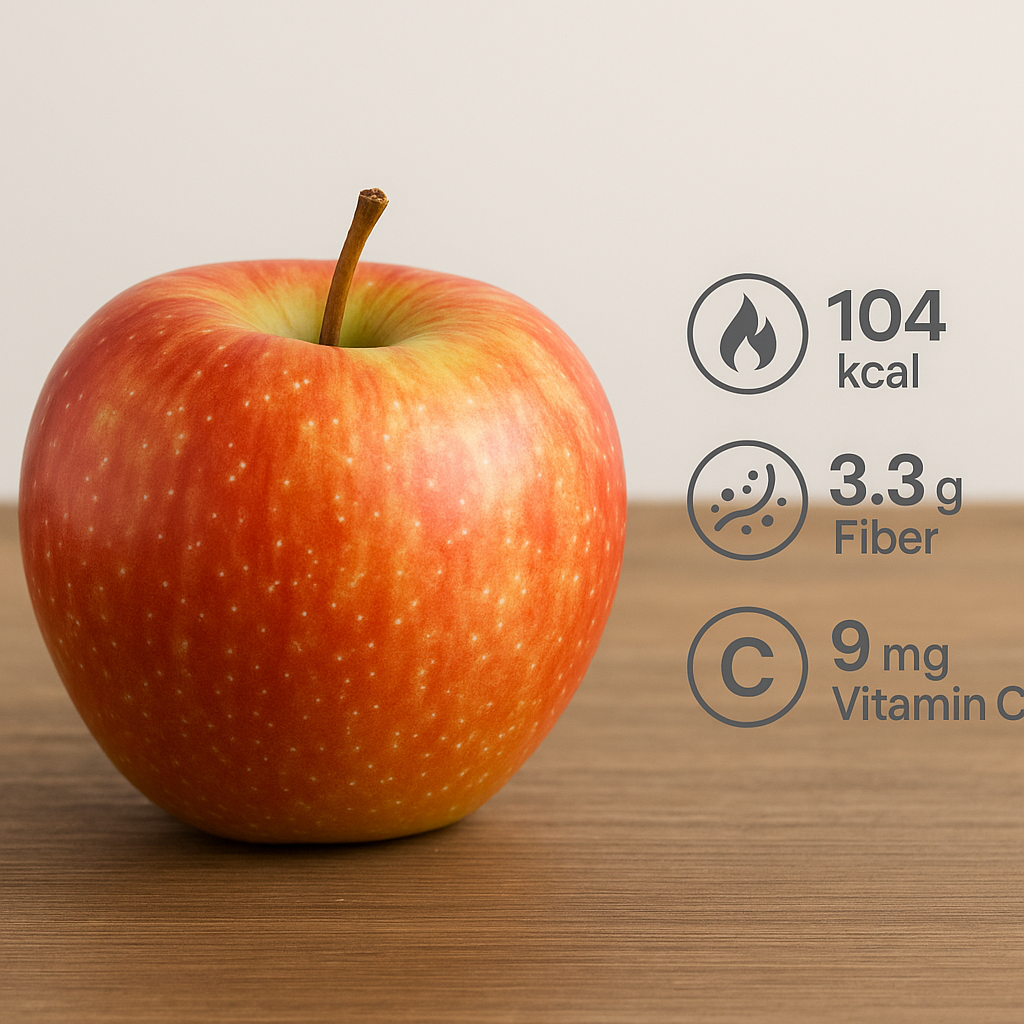Disclaimer
This article is for informational purposes only. Nutrient values are approximate and may vary by apple size and growing conditions. Always consult a healthcare or nutrition professional for personalized dietary guidance.
Sweet, crisp, and refreshingly juicy — the Honeycrisp apple is a modern favorite among fruit lovers. Known for its satisfying crunch and balanced flavor, it’s not only delicious but also nutritionally rich.
Developed in the 1990s by the University of Minnesota, the Honeycrisp quickly became one of the most popular apple varieties in the United States. But beyond taste, what does the Honeycrisp apple nutrition data reveal about its health benefits?
In this article, we’ll break down its calories, vitamins, minerals, sugar content, and how it compares to other apples. You’ll also learn how it supports digestion, heart health, and overall well-being.
What Makes Honeycrisp Apples Unique
The Honeycrisp apple was bred by crossing Keepsake and an unknown variety to produce a fruit that is exceptionally crisp, sweet, and aromatic.
Its key features:
- High water content (around 85%)
- Perfect balance of sugar and acidity
- Distinct “pop” when bitten
- Long storage life when refrigerated
Because of its high juiciness and low density, Honeycrisp apples have a refreshing texture that sets them apart from other varieties like Fuji, Gala, or Granny Smith.
Honeycrisp Apple Nutrition Data (Per 1 Medium Apple – Approx. 200 g)
| Nutrient | Amount |
|---|---|
| Calories | 104 kcal |
| Carbohydrates | 28 g |
| Sugars | 21 g |
| Dietary Fiber | 3.3 g |
| Protein | 0.5 g |
| Fat | 0.3 g |
| Sodium | 2 mg |
| Potassium | 215 mg |
| Vitamin C | 9 mg (10% DV) |
| Vitamin A | 2 µg |
| Calcium | 12 mg |
| Iron | 0.2 mg |
| Magnesium | 10 mg |
| Water Content | ~85% |
DV = Daily Value based on a 2,000-calorie diet.
Calories in Honeycrisp Apples
A medium Honeycrisp apple contains around 100 calories, which primarily come from natural carbohydrates — mainly fructose, glucose, and sucrose.
This makes it an excellent low-calorie snack for energy between meals. Because it’s rich in water and fiber, it helps you feel full longer, supporting weight management without adding unnecessary calories.
Comparison with other apples:
- Fuji Apple: 110 kcal
- Gala Apple: 95 kcal
- Granny Smith: 90 kcal
Honeycrisp sits comfortably in the middle — sweet but not overly caloric.
Carbohydrates and Natural Sugars
Each Honeycrisp apple provides about 28 grams of carbohydrates, of which 21 grams are natural sugars. These naturally occurring sugars are not the same as refined ones found in processed foods — they’re balanced with fiber, water, and micronutrients.
Because of the fiber-to-sugar ratio, Honeycrisp apples have a low glycemic index (GI of ~38), meaning they cause a gradual rise in blood sugar levels rather than sharp spikes.
Fiber Content and Digestive Benefits
One Honeycrisp apple provides roughly 3.3 grams of dietary fiber, which is about 13% of the recommended daily intake for women and 9% for men.
Apple fiber is mostly pectin, a soluble fiber that:
- Helps regulate digestion
- Promotes satiety and prevents overeating
- Supports healthy gut bacteria (prebiotic effect)
- May help lower LDL cholesterol
Eating the skin is essential, as that’s where much of the fiber and antioxidants are concentrated.
Vitamins in Honeycrisp Apples
Honeycrisp apples are not just sweet — they’re also rich in essential vitamins, particularly Vitamin C.
Vitamin C (Ascorbic Acid):
Each medium apple provides about 10% of your daily Vitamin C needs, which helps support:
- Immune function
- Collagen production (for skin and joints)
- Wound healing
- Iron absorption
Vitamin A:
Though minimal, Vitamin A in apples contributes to eye health and cell growth.
B-Complex Vitamins:
Trace amounts of B1 (thiamine), B2 (riboflavin), and B6 support metabolism and energy production.
Minerals in Honeycrisp Apples
| Mineral | Function | Amount (per medium apple) |
|---|---|---|
| Potassium | Regulates blood pressure and muscle function | 215 mg |
| Calcium | Bone and tooth health | 12 mg |
| Magnesium | Supports muscle relaxation and energy metabolism | 10 mg |
| Iron | Oxygen transport in blood | 0.2 mg |
| Phosphorus | Bone and cell health | 20 mg |
Potassium is the standout mineral here — it helps balance sodium levels, support heart function, and maintain fluid balance in the body.
Fat and Protein
Honeycrisp apples are naturally fat-free and very low in protein (less than 1 gram per apple).
Their macronutrient composition is:
- 95% carbohydrates (natural sugars + fiber)
- 3% fat
- 2% protein
This makes them ideal as a quick energy source rather than a protein- or fat-rich food.
Antioxidants and Phytochemicals
Honeycrisp apples contain a variety of polyphenols and antioxidants, especially in the skin. These compounds combat oxidative stress, reducing the risk of chronic diseases like heart disease and certain cancers.
Key antioxidants include:
- Quercetin: Anti-inflammatory and antihistamine effects
- Catechin: Supports cardiovascular health
- Chlorogenic acid: May help regulate blood sugar
- Phloridzin: Unique to apples, helps manage glucose absorption
Consuming apples with the skin maximizes antioxidant intake — peeled apples lose up to 30% of their polyphenols.
Hydration and Electrolyte Support
With 85% water content, Honeycrisp apples are naturally hydrating. The potassium in them also helps replenish electrolytes, making them a smart post-workout snack.
Unlike sports drinks, apples hydrate without added sugar, sodium, or artificial flavorings.
Honeycrisp Apple and Weight Management
Because they’re high in water and fiber, Honeycrisp apples are low in energy density — meaning they fill you up without packing on calories.
Research shows that people who eat whole fruits, especially apples, tend to have better weight control due to:
- Slow digestion of fiber
- Better satiety
- Reduced cravings for sweets
Replacing processed snacks with a Honeycrisp apple can easily cut 150–200 calories per day.
Blood Sugar and Diabetes
Despite their natural sweetness, Honeycrisp apples have a low glycemic index, making them safe for most people with diabetes when eaten in moderation.
Their fiber slows down sugar absorption, and polyphenols help improve insulin sensitivity. Pairing apples with a protein (like peanut butter or yogurt) further stabilizes blood sugar levels.
Heart Health Benefits
Apples, including Honeycrisp, support cardiovascular health in several ways:
- Soluble fiber (pectin) reduces LDL cholesterol.
- Antioxidants prevent oxidation of lipids in arteries.
- Potassium helps control blood pressure.
Studies have shown that people who consume apples regularly have a lower risk of heart disease compared to those who don’t.
Digestive Health and Gut Microbiome
Honeycrisp apples are a natural prebiotic food, meaning they feed beneficial gut bacteria such as Bifidobacteria and Lactobacillus.
This promotes:
- Better digestion
- Stronger immunity
- Reduced bloating
- Improved mental well-being (gut-brain connection)
The pectin fiber in apples is particularly valuable for maintaining a healthy microbiome.
Honeycrisp Apple vs Other Apple Varieties
| Variety | Calories | Sugar | Fiber | Vitamin C | Taste Profile |
|---|---|---|---|---|---|
| Honeycrisp | 104 kcal | 21 g | 3.3 g | 9 mg | Crisp, sweet-tart |
| Fuji | 110 kcal | 22 g | 2.8 g | 8 mg | Very sweet |
| Gala | 95 kcal | 20 g | 3.0 g | 8 mg | Mildly sweet |
| Granny Smith | 90 kcal | 16 g | 4.0 g | 7 mg | Tart |
| Red Delicious | 95 kcal | 19 g | 3.0 g | 6 mg | Sweet, mild |
Honeycrisp apples rank high in fiber and vitamin C, and offer a better balance of sweetness and crispness, making them both nutritious and satisfying.
How to Include Honeycrisp Apples in Your Diet
- As a snack: Eat raw with the peel for maximum fiber and nutrients.
- With nut butter: Pair slices with almond or peanut butter for protein and fat balance.
- In salads: Add thin slices to spinach, kale, or walnut salads for crunch.
- In smoothies: Blend with Greek yogurt and oats for a nutritious breakfast.
- Baked or roasted: Warm slices bring out natural caramel flavors without added sugar.
- With oatmeal: Dice into oatmeal or overnight oats for natural sweetness.
Storage and Selection Tips
- Choose firm, unblemished apples with bright red-yellow skin.
- Store in the refrigerator to maintain crispness — they stay fresh for up to 4–6 weeks.
- Keep away from other fruits to prevent ethylene-induced ripening.
- Wash thoroughly before eating to remove wax or pesticide residue.
Fun Facts About Honeycrisp Apples
- Developed in 1991 by the University of Minnesota’s apple breeding program.
- Originally named “Honeycrunch.”
- One of the first apples bred for texture, not just taste.
- Has explosive juiciness, with each bite releasing over 10% of its weight as juice.
- Typically costs more due to delicate handling and specific growing requirements.
Potential Downsides
While generally healthy, there are a few points to keep in mind:
- Natural sugar: Though natural, the 21g sugar per apple can add up for people on very low-sugar diets.
- Pesticide exposure: Apples are often listed among the “Dirty Dozen” fruits — wash or peel before eating if not organic.
- Digestive sensitivity: High-fiber foods may cause mild bloating in sensitive individuals.
Quick Recap of Honeycrisp Apple Nutrition
| Nutrient | Value per Medium Apple |
|---|---|
| Calories | 104 kcal |
| Sugar | 21 g |
| Carbohydrates | 28 g |
| Fiber | 3.3 g |
| Protein | 0.5 g |
| Fat | 0.3 g |
| Potassium | 215 mg |
| Vitamin C | 9 mg |
| Water Content | ~85% |
The Bottom Line
The Honeycrisp apple is more than a sweet snack — it’s a nutrient-rich fruit that supports hydration, digestion, and heart health. Packed with fiber, vitamin C, and antioxidants, it’s one of the most wholesome fruits you can eat.
Its crisp texture and balanced flavor make it enjoyable on its own or in recipes. Whether you’re managing your weight, improving gut health, or simply craving a natural sweet treat, a Honeycrisp apple fits right in.
Eat it raw, slice it into salads, or blend it in smoothies — either way, your body (and taste buds) will thank you.

